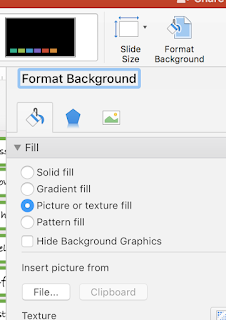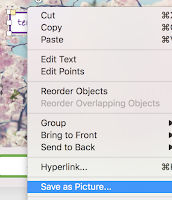I originally published this on FTEdTech
April is National Poetry Month, and a perfect time to inspire students to create their own poems about Spring.
Inspired by Eric Curts' "Springtime Magnetic Poetry with Google Drawings"
I created a template that we could use with iPads and one to use with Seesaw.
I love the format Curts uses in Google Drawings, but currently we cannot use Google Drawings on the iPad, so it requires a little modifying to give our students the chance for the same fun.
To modify the idea so we can use it on our devices with PowerPoint, Google Slides or Seesaw, I first created a background template in Canva using the "Presentation 16:9" size template. I inserted a free image related to spring from their stock images and downloaded it as a JPEG.

I inserted this image as the background of a blank PowerPoint slide by clicking:
Once the background was inserted, I was ready to create and insert the word magnets.
 I was feeling a little stuck on which words to use for Spring, so I hit up Google and found a great list at a site called Words to Use. To create the "word magnets", I inserted a rounded rectangle and changed the format so it would be easy to see on the background. I then typed in words and saved them as pictures by right clicking on the shape and choosing "Save as Picture..."
I was feeling a little stuck on which words to use for Spring, so I hit up Google and found a great list at a site called Words to Use. To create the "word magnets", I inserted a rounded rectangle and changed the format so it would be easy to see on the background. I then typed in words and saved them as pictures by right clicking on the shape and choosing "Save as Picture..."
I saved some time by reusing the same box over and over. I then went back in and inserted all the word pictures and arranged them on the sides and bottom of the template.
The extra step of creating these magnets as images will help as students drag and drop. To be flexible I added a template shape at the bottom so students will just have to touch the shape and add their own words. I decided to make this a different color so teachers would be able to see what were student generated words and what belonged with the template activity. It might be fun to have students insert appropriate emojis in the template box.
If you want to use this template with your students, you can find it in Schoology>>FTIS Elementary EdTech Group>>Resources>>Interactive Notebook Files>>Magnetic Poetry for Spring. I uploaded the template to Google and converted to Google Slides. You can grab a copy for Google Slides to use with your students if that format works better for you.
To distribute the assignment to your students, you'll want to upload it to your OneDrive or Google Drive and use Schoology Microsoft or Google Assignments so that you can create a copy of the template for each student. If you're not sure how to do that, check out the directions here.
 To give even our youngest students the opportunity to practice with the idea of magnet poetry, I created a similar activity in Seesaw.
To give even our youngest students the opportunity to practice with the idea of magnet poetry, I created a similar activity in Seesaw.
I used the same background and when creating the activity uploaded that image, and used the label tool to create the word "magnets". I also added in emojis for the students to use. For this version, students are additionally asked to create a recording of themselves reading their poems. This would a fun shared writing activity that would align to CCSS writing standards (W.K.2, W.K.6).
You don't have to reinvent the wheel with this one, you can grab a copy and edit the activity for your own needs and learning goals here.
Questions? Want to work together to make more activities like this? Let me know!
April is National Poetry Month, and a perfect time to inspire students to create their own poems about Spring.
Inspired by Eric Curts' "Springtime Magnetic Poetry with Google Drawings"
I created a template that we could use with iPads and one to use with Seesaw.
I love the format Curts uses in Google Drawings, but currently we cannot use Google Drawings on the iPad, so it requires a little modifying to give our students the chance for the same fun.
To modify the idea so we can use it on our devices with PowerPoint, Google Slides or Seesaw, I first created a background template in Canva using the "Presentation 16:9" size template. I inserted a free image related to spring from their stock images and downloaded it as a JPEG.
Setting up the Activity in PowerPoint

I inserted this image as the background of a blank PowerPoint slide by clicking:
- Design tab
- Format Background
- Picture or Texture Fill
- File
- Locate image and insert
Once the background was inserted, I was ready to create and insert the word magnets.
 I was feeling a little stuck on which words to use for Spring, so I hit up Google and found a great list at a site called Words to Use. To create the "word magnets", I inserted a rounded rectangle and changed the format so it would be easy to see on the background. I then typed in words and saved them as pictures by right clicking on the shape and choosing "Save as Picture..."
I was feeling a little stuck on which words to use for Spring, so I hit up Google and found a great list at a site called Words to Use. To create the "word magnets", I inserted a rounded rectangle and changed the format so it would be easy to see on the background. I then typed in words and saved them as pictures by right clicking on the shape and choosing "Save as Picture..."I saved some time by reusing the same box over and over. I then went back in and inserted all the word pictures and arranged them on the sides and bottom of the template.
The extra step of creating these magnets as images will help as students drag and drop. To be flexible I added a template shape at the bottom so students will just have to touch the shape and add their own words. I decided to make this a different color so teachers would be able to see what were student generated words and what belonged with the template activity. It might be fun to have students insert appropriate emojis in the template box.
If you want to use this template with your students, you can find it in Schoology>>FTIS Elementary EdTech Group>>Resources>>Interactive Notebook Files>>Magnetic Poetry for Spring. I uploaded the template to Google and converted to Google Slides. You can grab a copy for Google Slides to use with your students if that format works better for you.
To distribute the assignment to your students, you'll want to upload it to your OneDrive or Google Drive and use Schoology Microsoft or Google Assignments so that you can create a copy of the template for each student. If you're not sure how to do that, check out the directions here.
Setting up the Activity in Seesaw
 To give even our youngest students the opportunity to practice with the idea of magnet poetry, I created a similar activity in Seesaw.
To give even our youngest students the opportunity to practice with the idea of magnet poetry, I created a similar activity in Seesaw. I used the same background and when creating the activity uploaded that image, and used the label tool to create the word "magnets". I also added in emojis for the students to use. For this version, students are additionally asked to create a recording of themselves reading their poems. This would a fun shared writing activity that would align to CCSS writing standards (W.K.2, W.K.6).
You don't have to reinvent the wheel with this one, you can grab a copy and edit the activity for your own needs and learning goals here.
Questions? Want to work together to make more activities like this? Let me know!

This is a great poetry month activity for students. Thanks for sharing!
ReplyDelete